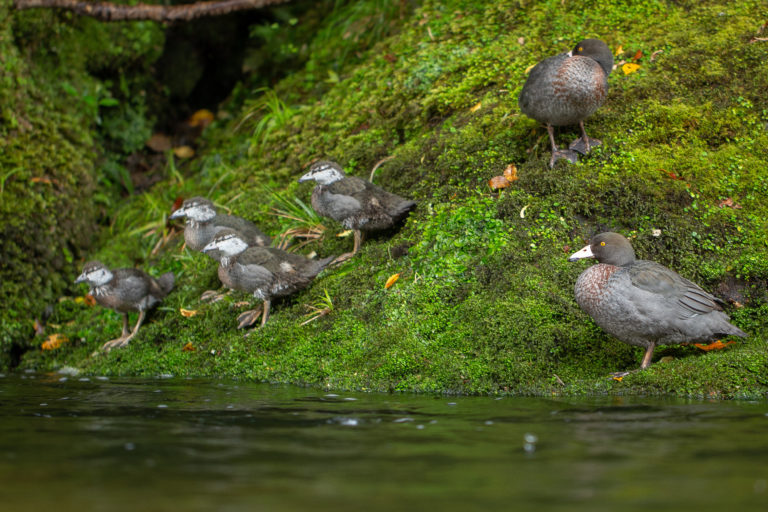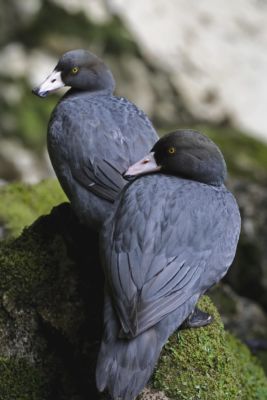Blue ducks (whio) live in both the North and South Island – they’re isolated by distance, but how isolated are they genetically? Physically there are visual differences – the South Island whio is larger, for example. But just how deep do those differences go?

Genetic difference matters when it comes to conservation management – especially where a species is subject to translocations. Small isolated populations can become inbred, so mixing up the genes with some ‘new blood’ can be a good thing in many cases, adding to species resilience. On the other hand, if nature and the Cook Strait Divide are in the process of diverging whio into two distinct subspecies, with measurably different genetic makeup, then there is a strong argument for working with nature and not artificially enabling the two populations to interbreed.

Currently the North and South Island whio are managed as distinct populations, with translocations being limited to within the originating island. Modern genetic techniques mean that it is possible to determine whether this is, in fact, the best management practice for the species.
Researchers from the Anatomy and Zoology departments at the University of Otago have recently been checking out blue duck genetics to see just how closely related the North and South Island populations are. The results of their study have been published in Conservation Genetics and are freely available under Open Access.
What’s so special about whio?
“The New Zealand endemic blue duck or whio (Hymenolaimus malacorhynchos) is considered as ‘threatened’ under the New Zealand Threat Classification System and is ranked as endangered in the IUCN red list, with its population trend decreasing. The blue duck remains one of the least well-known duck species… Most recent estimates indicate a total population size of 2500 to 3000 individuals.”
Why are whio in trouble?
“Peculiar ecological traits make this species particularly vulnerable to some of the main drivers of species extinctions, such as habitat loss and introduced predators. Specifically, this species is one of only four specialized duck species worldwide that live permanently in rivers… Blue ducks are long-lived, forming stable pairs that defend territories corresponding to river stretches of about 1.5 km, resulting in low-density populations. Once widespread throughout most of the North and South Island of New Zealand, blue ducks are now limited to upstream parts of unmodified rivers, characterised by high water quality, high stability of the stream banks as well as abundant invertebrate prey.”
Stoats, people and hydro dams…
“Stoats (Mustela erminea) have been identified as one of the main agents of decline at some sites, along with deforestation and the development of hydro dams for electricity generation.”
So what are we doing about it?
“Translocations, particularly the extraction of eggs from the wild and subsequent release of fully-fledged birds (Whio Operation Nest Egg) as well as the release of captive-bred birds, are being used as important management tools in this species.”
What do we currently know about whio genetics?
“Following a (previous) phylogeographic study of mitochondrial DNA that revealed a deep genetic split between North and South Island and significant genetic structuring within islands, blue duck translocations have been restricted to within island movements of birds. Currently information on range-wide nuclear genetic diversity, and thus male dispersal rates, is lacking for this species, but understanding fine scale population structuring, as well as natural dispersal, is crucial in maximising success of any future translocation actions.”
What’s the research process?
Feather samples were obtained from whio populations in the Central North Island, Ruahines and Bay of Plenty regions, along with Kahurangi, Fiordland, Central South Island and South Canterbury in the South Island.
“Seventy-five samples from six North Island (NI) and five South Island (SI) sites were obtained from an earlier study by Robertson et al. Feathers were collected between 2002 and 2009 from an additional 194 birds and two NI and five SI sites and stored in paper envelopes or plastic bags with silica gel. Genomic DNA was extracted from feathers”
The science gets ‘technical’…
The research paper then describes the analysis that was then carried out – in somewhat specialised technical detail. It undoubtedly makes sense to those with the necessary genetic knowledge, but the rest of us may find the description in the abstract sufficient:
“…we examine the patterns of variability at 11 microsatellite loci and mitochondrial control region data to assess the range-wide genetic diversity and population structure of blue duck. Our data suggest that North and South Island blue duck populations likely diverged in the late Pleistocene with very limited gene flow, strongly reinforcing the current management strategy to avoid translocation between islands.”
The late Pleistocene (according to Wikipedia) began around 126,000 years ago and ended about 11,700 years ago. Suffice to say, the North and South Island’s whio populations have been keeping to themselves for some considerable time – long before any humans arrived on the scene – so the current translocation management practice of maintaining that divide would seem to be the correct one.
Revelations on dispersal
Within the North and South Islands, however, whio populations may be mixing more than had previously been assumed.

“Overall, our analyses suggest that blue duck dispersal between catchments, and on wider geographic scales, is greater than what had been assumed for many years… Interestingly, several recent studies, involving increased field observation efforts, have detected blue duck dispersal events on larger scales. Specifically, Whitehead et al. (2007) reported juvenile males moving up to 24 km away from their natal area in Fiordland. Similarly, Bristol et al. (2008) reported a juvenile banded in the Whanganui catchment was observed 30 km away in the Tongariro River.”
Overall, however, blue ducks appear to have low genetic diversity and a small ‘effective population’ size.
“Genetic diversity within both islands follows a pattern of isolation by distance with relatively high levels of gene flow among populations, likely driven by male–juvenile dispersal. The overall genetic diversity in blue duck is low and effective population size is small. These data will provide important information for conservation management of this species.”
Lack of genetic diversity and low effective population size mean the whio may be more at risk than previously realised.
“Estimates of blue duck contemporary effective population size revealed that a substantially smaller number of breeders genetically contribute to NI and SI populations (~100 individuals each) than previous breeding pair counts imply (1200 pairs). Given this small effective population size, blue duck are potentially at risk of further loss of genetic diversity due to genetic drift as well as inbreeding.”
Implications for DOC whio recovery plan
The researchers also identified implications their findings have for the Department of Conservation’s current 10-year Whio Recovery Plan.
“Overall, we found strong concordance between these predefined sites (in the Recovery Plan) and results reported here. However, the detected higher genetic diversity and identification of at least two genetic clusters in the South Island warrants the establishment of additional security sites, particularly in Central South Island and Fiordland. Our results also suggest that more than 50 breeding pairs should be protected within a security site, as a much smaller number of individuals is likely to genetically contribute to the population than are protected within a site.”
The full article is published in Conservation Genetics and is freely available online.
Strong isolation by distance argues for separate population management of endangered blue duck (Hymenolaimus malacorhynchos) (2017)

